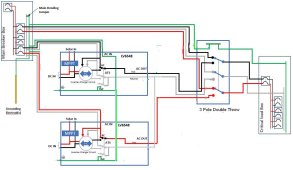Current, not voltage will run between the 2 inverters on both the neutral and ground. There shouldn't be voltage, the neutral and ground are bonded together at each end. If you did have voltage, then either bonding of N-G is not present or you have resistance in a connection.
Ground and neutral will be bonded together inside each inverter under inverter power.
It isn't grid power that is an issue if a 3 pole double throw is used and neutral is switched. There will be objectionable current between both inverters on the EGC due to both inverters having N-G bond under inverter power. The battery charger isn't needed, the charger in the inverters will work fine and safely.
The conversation is all about the N-G bond on each inverter under inverter power and the resulting objectionable current that will occur on the EGC between both inverters due to the parallel path with neutral. My approach is to manage the current without removal of the EGC on the inverters and keep the length as short as possible. I consider the 2 inverters as one 240V split phase generator and the objectionable current is confined between the 2 inverters. The EGC between the 2 would be less than 2 feet. There is no other way around this unless either neutral for each inverter is kept isolated from the other neutral, this would require 2 subpanels, one dedicated with it's neutral to it's corresponding inverter. This is impractical and unnecessary. Second option would be to not have the EGC on either inverter. I consider that unsafe. A short to case in the inverter could turn the case hot. Next option is removal of the ground screw for the N-G inside the inverter. I consider this unsafe also.
This is my solution. It is the best option after many threads of discussion. The only objectionable current would be between the 2 inverters when under inverter power.
View attachment 87093




